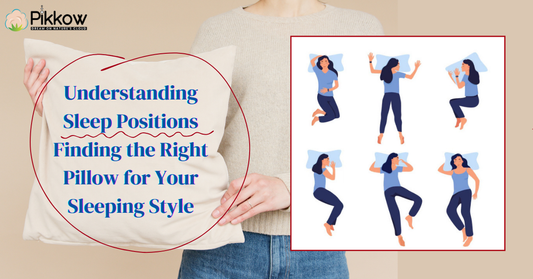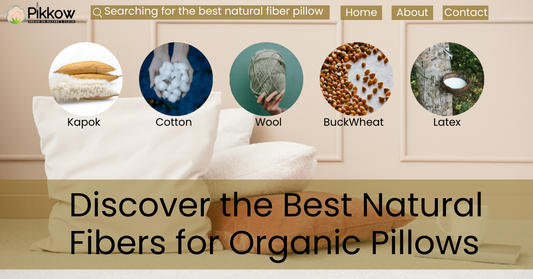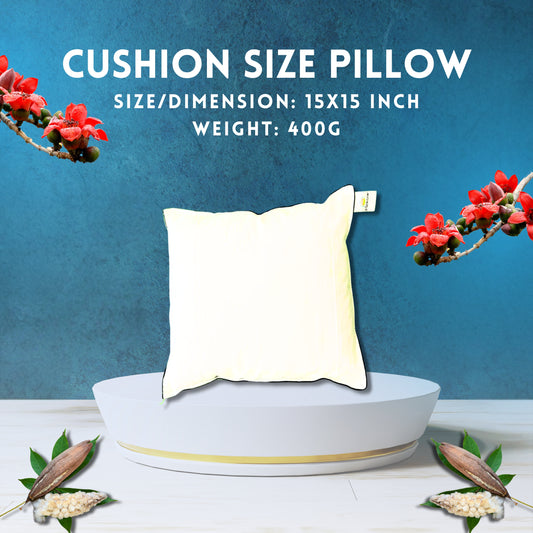Pillows are an essential part of a good night’s sleep. They provide the necessary support for your neck and head, ensuring that you wake up feeling refreshed. However, one of the most common frustrations pillow owners face is dealing with a pillow that goes flat over time. If you've ever asked yourself, "Why do my pillows go flat?" or "Why do pillows go flat so fast?", you're certainly not alone. But don't worry! There’s a solution that can help you enjoy your pillow for much longer i.e., Pikkow’s Kapok pillows.
In this blog, we’ll explore the reasons behind why pillows flatten and how choosing the right materials, like Pikkow Kapok pillows, can make a world of difference.
Why Do Pillows Go Flat?
Pillows go flat over time for several reasons:
- Compression of Filling Material: Most pillows, whether filled with down, feathers, memory foam, or synthetic materials, get compressed as you sleep on them. Repeated pressure from your head and neck gradually flattens the filling.
- Wear and Tear: The fibers or foam inside the pillow lose their elasticity after regular use, making them less supportive. This is particularly common in synthetic-filled pillows, which break down faster than natural materials like down.
- Moisture: Sweat, oils from your skin, and humidity can accumulate in pillows. This moisture can break down the filling over time, causing it to lose volume and shape.
- Improper Washing or Drying: Washing a pillow improperly, or not drying it completely, can also lead to flattening. Memory foam, for instance, should never be machine-washed, as it loses its structure when wet.
- Age: Pillows have a limited lifespan. After 1-2 years, most pillows lose their original form and become flat due to continuous use.
The Solution: Pikkow Kapok Pillows
Now that we understand why pillows go flat, it’s time to explore a solution that can help you keep your pillow fluffy for longer: Pikkow Kapok pillows. If you're tired of constantly replacing flat pillows and dealing with poor neck support, this could be the answer to your problem.
1. What is Kapok?
Kapok is a natural fiber that comes from the seed pods of the Ceiba tree, which is native to tropical regions of Asia, Central America, and Africa. The kapok fibers are soft, silky, and light, yet extremely resilient. They have been used for centuries in various applications, from stuffing mattresses to creating flotation devices. Kapok fibers are known for their ability to maintain their fluffiness and shape over time, making them an excellent choice for pillows.
Unlike synthetic fills, which break down and compress over time, Pikkow Kapok pillows are made from sustainably harvested kapok fibers that naturally resist flattening. When you rest your head on a Pikkow Kapok pillow, the fibers gently conform to your shape while still maintaining their loft. This ensures long-lasting comfort and support, without worrying about your pillow going flat prematurely.
2. How Pikkow Kapok Pillows Stay Fluffy Longer
Pikkow Kapok pillows are designed to provide the perfect balance of softness and support. Unlike down or polyester-filled pillows, which can become compacted after repeated use, kapok fibers have a unique structure that allows them to spring back into shape. This makes them much more resilient to compression and ensures that your pillow retains its fluffy, full shape even after months or years of use.
The kapok fibers inside the pillow are naturally hollow, allowing air to circulate freely. This helps the pillow maintain its loft and ensures it stays light and breathable. Kapok is also hypoallergenic, which means it’s less likely to trap dust mites or bacteria, making it a healthier option for those with allergies or respiratory issues.
3. Sustainability and Eco-Friendliness
Another benefit of Pikkow Kapok pillows is their environmental impact. Kapok is a sustainable, eco-friendly material because it is harvested from trees without the need for deforestation. Unlike synthetic pillows, which are made from petroleum-based products, kapok is biodegradable and doesn’t contribute to plastic pollution.
By choosing kapok pillows, you're not only making a comfortable choice for your sleep, but also making a conscious decision to support environmentally friendly practices. Pikkow Kapok pillows are cruelty-free, as no animals are harmed in the process of harvesting kapok fibers, unlike down-filled pillows.
4. Durability and Long-Term Comfort
When you invest in a Pikkow Kapok pillow, you're making a long-term investment in your sleep quality. Because of the unique properties of kapok fibers, Pikkow pillows stay fluffy for much longer than traditional pillows. You won’t have to replace them as often, saving you money in the long run. Plus, you’ll enjoy better neck and head support each night, ensuring a restful and restorative sleep.
Key Features of Pikkow’s Kapok Fibre Pillows
Kapok fiber, sometimes referred to as "silk cotton," is a natural fiber derived from the seed pods of the kapok tree (Ceiba Pentandra). Here are some key features of kapok fiber cotton:
- Lightweight: Kapok fiber is extremely light, which makes it a popular filling material for pillows, mattresses, and stuffed toys. It is often compared to down feathers in terms of its lightness.
- Hypoallergenic: Unlike some other natural fibers, kapok is generally hypoallergenic and does not cause irritation to sensitive skin. This makes it suitable for people with allergies.
- Soft and Cushiony: Kapok fibers are soft, making them an excellent choice for providing cushioning in pillows and cushions. It provides a fluffy, plush feel.
- Water-Resistant: The fiber has a natural wax coating that makes it water-resistant. This helps kapok fibers retain their buoyancy and ensures they don't absorb moisture easily.
- Eco-Friendly: Kapok is biodegradable and an environmentally friendly alternative to synthetic materials. Since it's a renewable resource, it has a low environmental impact compared to some other filling materials.
- Breathable: Due to its air-filled structure, kapok is highly breathable, which helps regulate temperature and keeps the material cool.
- Durable: Though soft, kapok fibers are relatively durable and can withstand regular use. However, they may compress over time, losing some of their loft.
- Sustainability: Kapok trees grow in tropical climates, and harvesting the fibers doesn’t require the cutting down of trees, making it a sustainable material choice.
Kapok is a versatile material, widely used in bedding products, upholstery, and even as an alternative to down feathers. However, it's not as widely available as other filling materials, which can make it less common in mass-produced goods.
How to Care for Your Pikkow Kapok Pillow
To get the most out of your Pikkow Kapok pillow, it’s important to follow some basic care instructions. While kapok pillows are naturally resistant to flattening, proper care will help maintain their fluffiness and longevity.
- Fluff Regularly: Just like any pillow, it’s important to fluff your Pikkow Kapok pillow every day to maintain its loft. This helps prevent the fibers from becoming compressed over time.
- Use a Pillow Protector: To keep your pillow fresh and clean, consider using a pillow protector. This will shield it from sweat, dust, and other elements that could break down the fibers.
- Wash Carefully: While kapok pillows are durable, it’s important to wash them gently if needed. Hand wash or use a gentle cycle with cold water. Avoid using harsh detergents, and never use bleach.
- Air Dry: After washing, allow your pillow to air dry completely. Avoid using a dryer, as high heat can damage the fibers and reduce the pillow’s lifespan.
Conclusion: The Future of Comfortable, Fluffy Pillows
If you're tired of pillows that flatten too quickly and don’t provide the support you need, it’s time to make the switch to Pikkow Kapok pillows. With their natural, resilient fibers, kapok pillows provide long-lasting comfort and support, keeping your head and neck aligned throughout the night. No more worrying about your pillow going flat or losing its shape after a few months.
By choosing Pikkow Kapok pillows, you’re not just investing in better sleep, but also in an eco-friendly, sustainable, and hypoallergenic solution. Say goodbye to flat, uncomfortable pillows and enjoy a fluffier, more restful sleep experience with Pikkow Kapok.
FAQ:
1. What is Kapok Fiber Cotton?
Kapok fiber cotton is a natural, lightweight, and soft fiber derived from the seed pods of the kapok tree (Ceiba Pentandra). It's often used as a filling material in pillows, mattresses, and cushions due to its plush, breathable, and hypoallergenic properties.
2. What are the benefits of using Kapok Fiber?
Kapok fiber offers several benefits, including being lightweight, soft, and eco-friendly. It's also hypoallergenic, water-resistant, breathable, and provides excellent cushioning. Kapok is a sustainable material that has a low environmental impact compared to synthetic alternatives.
3. Is Kapok Fiber Cotton hypoallergenic?
Yes, kapok fiber is hypoallergenic, making it a suitable choice for people with sensitive skin or allergies. It does not irritate the skin like some other fibers, providing a comfortable and safe sleep experience.
4. How does Kapok Fiber compare to synthetic fibers?
Kapok fiber is a natural alternative to synthetic fibers. Unlike synthetic options, kapok is biodegradable, eco-friendly, and breathable. It offers a soft, plush feel similar to down feathers but is lighter and more sustainable.
5. Can Kapok Fiber Cotton be used in bedding products?
Yes, kapok fiber is commonly used in bedding products like pillows, mattresses, and cushions. Its softness, breathability, and hypoallergenic properties make it ideal for creating comfortable, supportive bedding.
6. Is Kapok Fiber suitable for people with allergies?
Kapok fiber is ideal for people with allergies. Its natural properties make it less likely to harbor dust mites and allergens compared to other materials, providing a hypoallergenic and comfortable option for those with sensitivities.
7. Why should people use Kapok Pillows instead of other pillows?
Kapok pillows are eco-friendly, lightweight, and hypoallergenic, making them a great alternative to synthetic or feather pillows. Their breathable and temperature-regulating properties ensure a comfortable, cool sleep. Additionally, kapok is a sustainable, natural material that offers plush support while being gentle on the environment.











